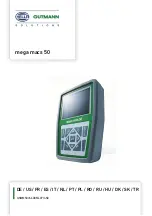
SONOSAX SX-R4
User interface V4.2
Page 18 de 32
SETUP > ROUTING SETTINGS > MIRRORING
When the MIRRORING function is activated, the routing and the eventual mixing level of the input channels
onto the hard disk tracks is identically replicated on the Compact Flash card. The tracks are recorded
simultaneously on the hard drive and on the CF card providing that the performances of the CF card permits.
When the Mirroring is activated, the two tracks of the CF card no longer appear in the routing matrix and are
replaced by the word MIRROR.
NOTE:
Several series of tests with CF cards offering good performances helped to validate the
recording of up to 8 channels at 96kHz/24bit. If the performances of the CF card does not
allow mirroring, an alarm "CF" will flash on the screen. The recording on the CF card will be
aborted but will continue on the HD.
NOTE:
If the storage capacity of the CF card is reached during the recording, the CF card will stop
recording but the recording will continue on the hard disk.
4.6.3
RECORD SETTINGS
SETUP > RECORD SETTINGS > BIT PER SAMPLE
This menu sets the sample's quantization (number of bits per sample) stored in WAVE files. Although the
A/D converters of the SX-R4 exclusively convert in 24 bits mode, the DSP can re-quantize the recorded
samples by the following values:
•
24 bits: original value as quantified by the A/D converter
•
16 bits Dithering: reduction to 16bits per sample with triangular dithering
•
16 bits: reduction by truncation of the original quantization
SETUP > RECORD SETTINGS > SAMPLING FREQUENCY
This menu sets the sampling frequency. Choices are: 44.1, 48, 88.2, 96, 176.4 and 192 kHz.
If an AES input is assigned, the SX-R4 will automatically lock on sampling frequency of the incoming AES
signal, thus the selected sampling frequency will be overwritten. The sampling frequency of the incoming
AES signal can be controlled in the UNIT STATUS.
SETUP > RECORD SETTINGS > SAMPLING UP / DOWN
The sampling frequency can be set either at its nominal value or pulled Up or Down for the NTSC world; in
which case the nominal sampling frequency is increased or decreased by 0,1% ( or one per thousand).
When the sampling Up or Down is chosen the symbol " %+ " or " %- " is displayed on the upper right corner
of the main screen.
C Mode is a special "compensated" mode faking the pull Up/Down; the recording is performed at nominal
sampling rate and the stamped value indicates 48000 which is the true number of samples per second;
however the Time Code is compensated (or cheated) so that the Time is stamped as if the digitization was
done at 48048 (the Time Stamp is computed by counting the number of samples since midnight)















































